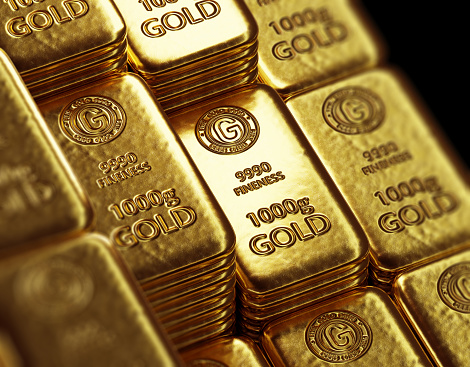Escalating geopolitical tensions, apprehensions over US policy decisions and feeble global economic outlook sent gold prices to new lifetime highs last week. On the key London spot market, prices are hovering above $2500 an ounce, gaining more than 22 percent so far this year.
However, domestic gold prices recuperated most of its earlier losses, thanks to a bullish overseas market and weak Indian Rupee.
In the last week of July, Indian gold plunged drastically followed by a sharp cut in import duties. It buckled from an all-time high of Rs 74,700 per ten grams to a six-month low of Rs 67,400 levels in the futures market. However, currently it is placed well above Rs 72,000 per ten grams.
GoI slashed customs duty on gold and silver
Government of India had slashed the duty on gold and silver to 6 percent in the latest Union budget. The basic customs duty reduced to 5 percent from 10 percent, and the Agriculture Infrastructure and Development Cess lowered to 1 percent from 5 percent. Now the overall duty on gold and silver in the country is 9.5 percent inclusive of GST.
The duty cut move was a long-standing demand from the stakeholders. Indian government had an approach of hiking duties on gold for decades to curb imports which was one of the major reasons for widening our current account deficit.
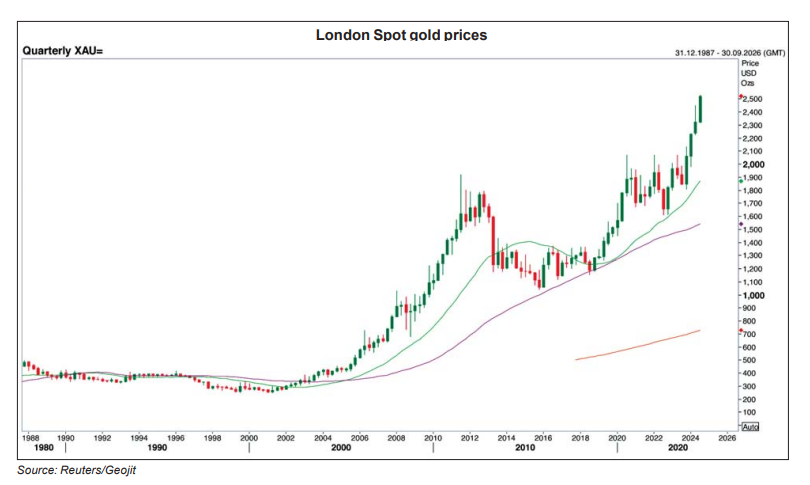
Earlier, high duty and taxes on gold had widened the price gap between domestic and overseas gold, which prompted imports through illegal channels and resulted in revenue losses for the government.
India is the second largest gold consumer and most of its demand is met by imports. Data shows gold smuggling in India was around 100 tonnes in 2022 and it increased to 155 tonnes in 2023 due to a sharp rise in prices.

A likely boost for domestic gold market
The cutting down of import costs will reduce the price difference between overseas market and it may lead to a decline in gold smuggling to the country. Simultaneously, this decision would lead to lower input costs, stimulate domestic manufacturing and most importantly boost the export competitiveness of domestic jewellers.
Though higher imports are likely to further widen India’s current account deficit, government aims to make gold affordable for Indian consumers and support various stakeholders. A vibrant and strong domestic market may increase the use of recycled gold and export competitiveness which may be good for the economy.
Gold prices are on bullish track
Gold price was skyrocketing in the past few years. The benchmark London spot gold and domestic prices had gained over 50 percent in the last two years. The rise in prices was primarily due to a combination of factors like escalating geopolitical tensions, US rate cut speculation, higher central bank buying and moderate global growth outlook.
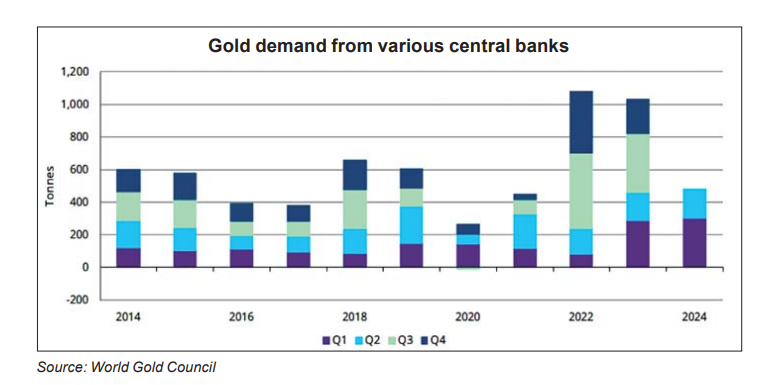
Escalating geopolitical tensions
The Middle East tensions and the war between Russia and Ukraine bolstered the safe-haven demand for bullion. The recent Gaza conflict has caused significant tensions in the Middle East, especially since the hostility between Israel and Iran is at its highest.
Geopolitical tensions play a crucial role in shaping gold market sentiment and influencing the price. As a tangible asset that holds intrinsic value, gold often becomes a preferred investment during times of uncertainty, driving its price upwards.
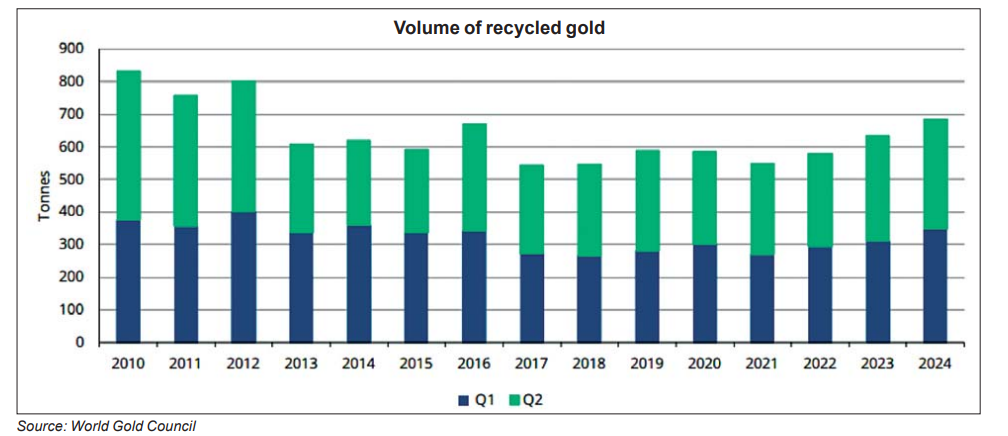
Global growth outlook
Expectations of a moderate global growth forecast led investors to rely on gold. A weak global economy drives investors towards gold as a reliable store of value.
The global GDP growth is projected at 3.1 percent in 2024 changed little from the 3.1 percent in 2023. There are estimations of a decline in developed economies like Germany, Japan, and the UK this year. In addition, persistent worries over China’s economy forced investors to buy gold as a hedge against inflation.

Hopes of US rate cuts
Expectations over US rate cuts, which may cause a decline in the dollar, are keeping the momentum higher. There are forecasts that the US Federal Reserve will deliver the long-awaited interest rate cut in September. In the low-interest rate environment, gold like non-yielding assets tends to shine.
A cut in interest rates will cause lower yield for dollar-denominated assets, which can lead to a decline in the value of the US dollar.
Higher central bank demand
Central banks are the key demand driver of gold in recent times. As per World Gold Council data, central banks have accelerated gold purchases to above 1000 tonnes per year in 2022 and 2023. In the face of seemingly challenging conditions like higher yields and US dollar strength, there are forecasts that the central banks’ appetite for gold would continue this year as well.
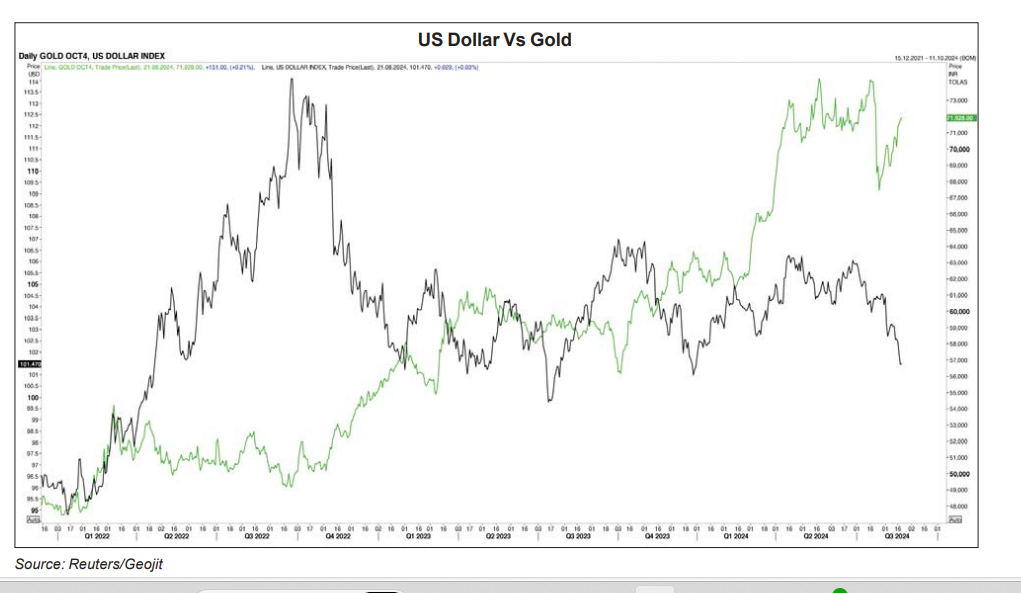
Outlook remains bullish
The near-term outlook of gold continues to be positive due to reasons like escalating geopolitical tensions, US policy uncertainties, higher central bank buying and downbeat global growth outlook. A possible increase in Indian consumption due to a cut in duties may further support prices.
Historically, gold has given good returns to its investors over a period. Since the present market dynamics remain positive, gold may retain its positive outlook in the long run as well. However, as numerous factors would affect its demand and supply, it may succumb to high price volatility frequently. It is advisable that long-term investors can continue to hold 8-10 percent of their total holdings in gold and related assets by adding more when there is a correction in prices.

